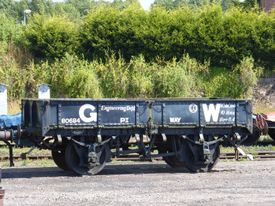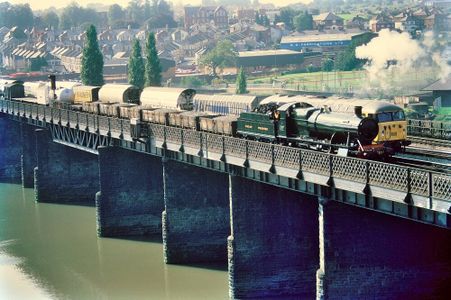GWR 80684 Ballast Wagon
| GWR 80684 Ballast Wagon | |
|---|---|
 GWR 80684 Ballast Wagon (2015) | |
| Built By | GWR Swindon |
| Number | 80684 |
| History | |
| Built | 1936 |
| Diagram | P15 |
| Lot | 1215 |
| Type | 4-wheel ballast wagon |
| Capacity | 10 tons |
| Telegraphic code | STARFISH (BR) |
| TOPS code | ZAO |
| 1985 | Arrived on SVR |
| 1985 | Appeared on the main line |
The GWR did not allocate telegraphic codes to Departmental wagons of this type, although it was later classified as a STARFISH by BR.
Contents
Service and preservation
80684 was built at Swindon circa 1936-37 to Diagram P15 as part of Lot 1215. It finished its working life with BR(W) at Swindon around the end of 1984, having been fitted with a new floor by BR shortly before being decommissioned.[2] Having been condemned there, it was purchased by The GWR 813 Preservation Fund but was then 'lost', turning up in use in an engineering train at Gloucester several months later.[3][note 2]
Some eleven years before 80684's preservation, the SVR had become home to three other 10-ton ballast wagons, all of which were acquired from Swindon in November 1973 for P-Way work. 80225 and 80603 (both Diagram P15) were owned by SVR(H), while Diagram P18 wagon 30903 was owned by the GWR 813 Fund. 80684 arrived on the SVR in April 1985. With the floor having been recently replaced, it was in generally good condition apart from one cracked axlebox which was repaired in July of that year. A quick repaint in GWR Engineers' black livery was also carried out at the same time; the entire job taking just over a week.[4]
Two months later 80684, 80225 and 80603 all appeared on the main line as part of the GW 150 demonstration freight train which ran to Newport in September 1985 behind GWR freight loco 2857.[4]. The four wagons then continued in P-Way service, the 1998 Stock Book noting that they were "...in almost daily use up-and-down the Railway."
80684 continued in SVR service with only 'routine maintenance' until being stopped in 2005 with damage to the axlebox casting, an issue common to these wagons as described in the article on sister wagon 80603. The overhaul began in Autumn 2006 with the initial plan being simply to fit modified door stop springs, replace the axlebox casting, and return the wagon to service. However inspection showed that use of the wagon for the storage of locomotive ash had resulted in corrosion of the end panels of the steel body. These were removed, new material cut to size and drilled ready for riveting. Removal of the end panels revealed that the corner uprights were also badly corroded. These were removed in turn and new corners fabricated using left-over steel from another repair job at Bewdley.[3] The new parts were welded in place and a new floor was also welded in using thicker 8mm plate to help extend its life span. After repainting in GWR Engineers' black livery, the wagon was "...returned to P. Way (ab)use" in February 2007.[5]
80684 is still owned by The GWR 813 Preservation Fund, although most P-Way work is now carried out by larger and more modern BR-era ballast wagons such as the Rudd and Seacow.

